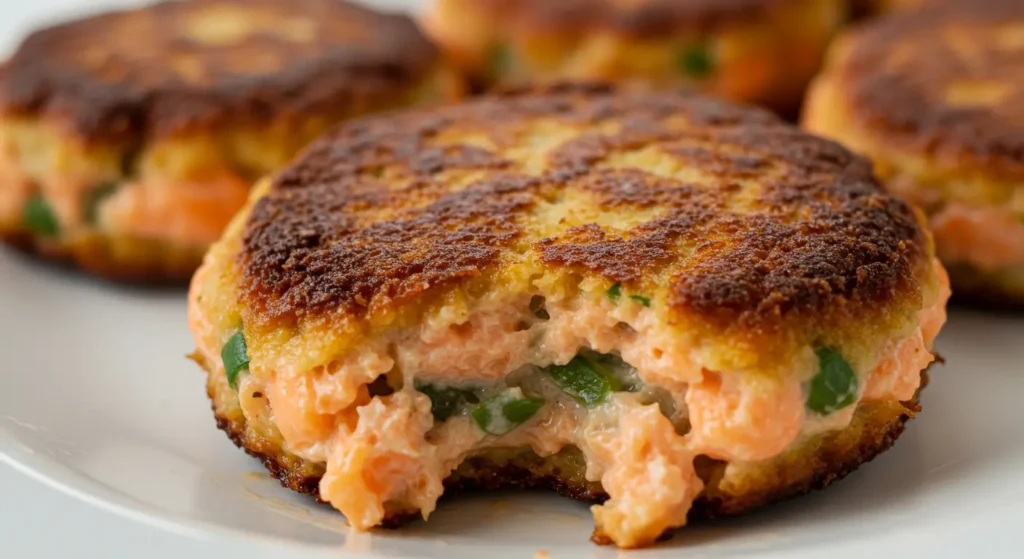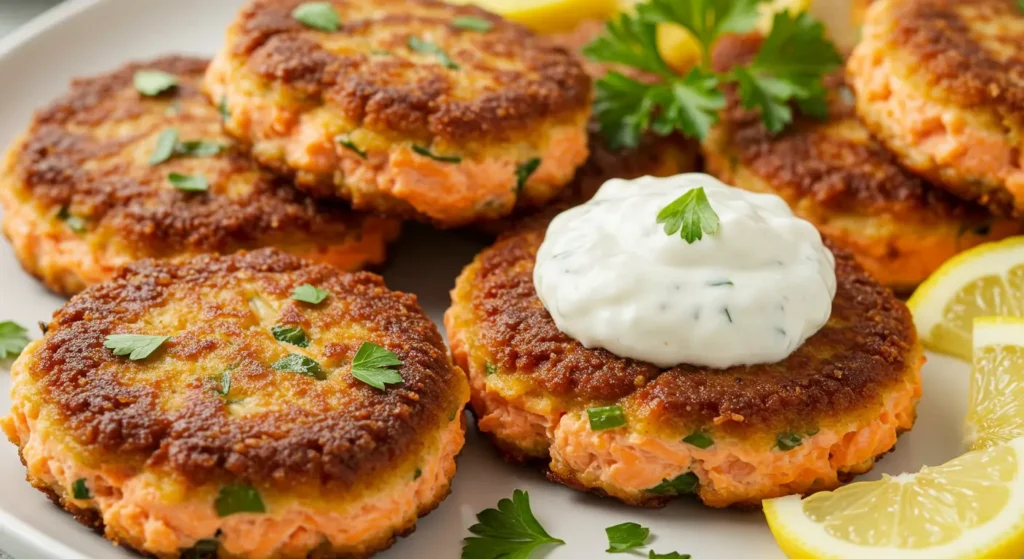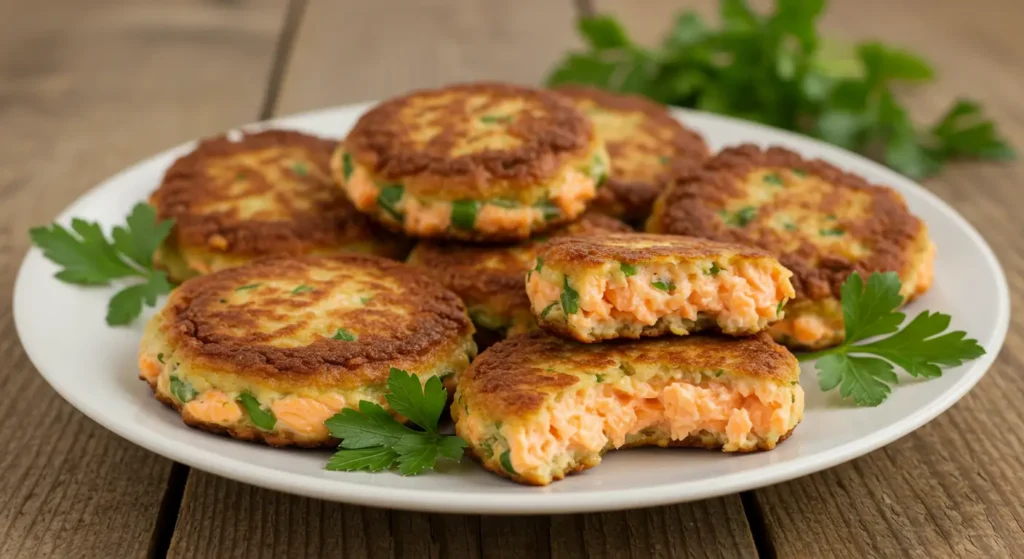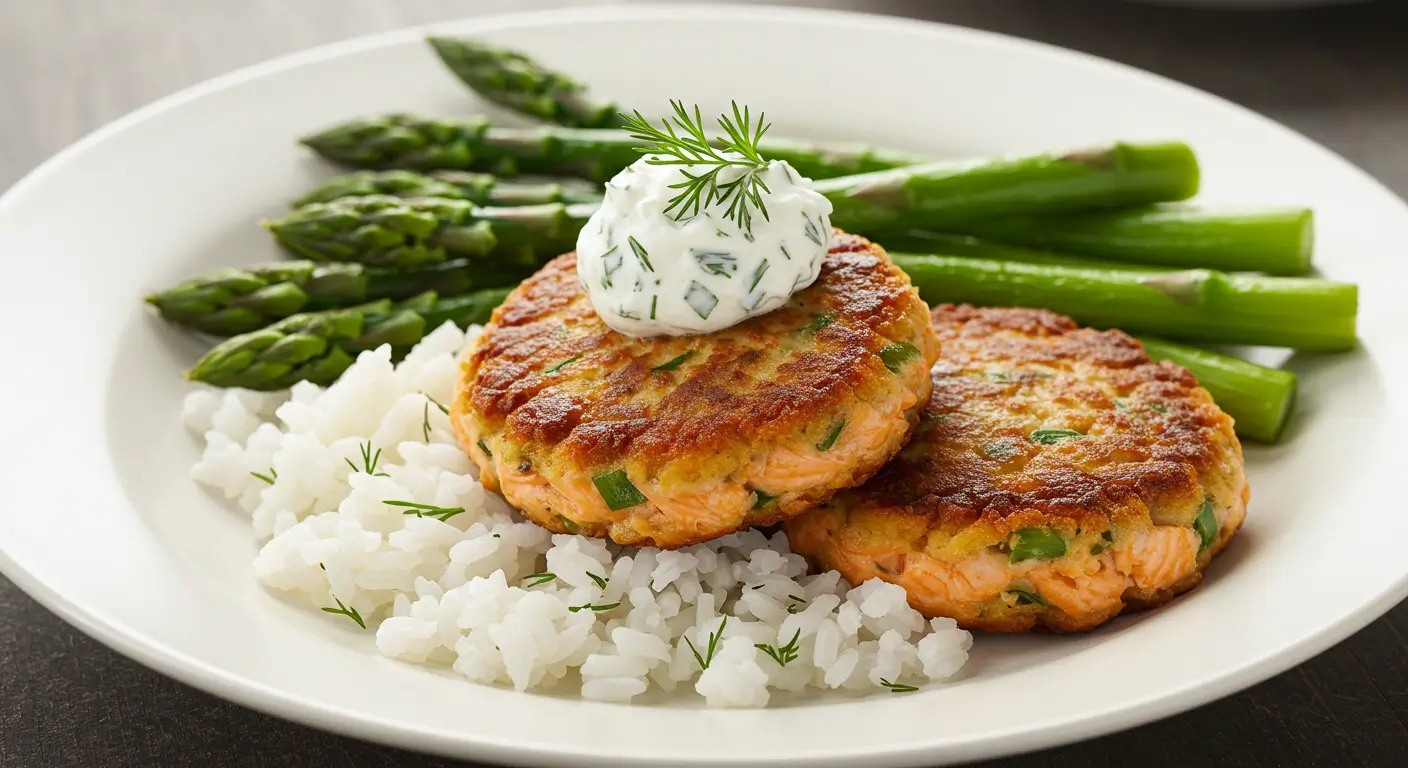Delicious Salmon Cakes
Table of Contents
Are you searching for a seafood delight that’s tasty and healthy? Look no further than salmon cakes. This dish is cherished by people worldwide for its delightful flavors.
These flavorful patties offer a delightful experience for your palate. They’re also a smart choice for healthy eating. Made from fresh ingredients, salmon cakes are a tasty way to enjoy seafood’s benefits.
Key Takeaways
- Salmon cakes are a nutritious and flavorful seafood option.
- They can be crafted using various ingredients to cater to diverse preferences.
- Salmon cakes are a great way to incorporate healthy eating into your diet.
- They can be served in a variety of settings, from casual meals to formal dinners.
- Salmon-cakes are a versatile dish that can be enjoyed by people of all ages.
The Appeal of Salmon Cakes
So, why do people love salmon cakes so much? It’s because they taste great, are easy to make, and are good for you.
The History and Origin of Salmon Cakes
Salmon cakes have a rich history. They started as a way to use up leftover salmon. Now, they’re a favorite dish around the world. They show how creative cooking can turn simple ingredients into something amazing.
Nutritional Benefits of Salmon
Salmon is not just tasty; it’s also full of good stuff. Eating salmon can help you stay healthy because of its omega-3 fatty acids and protein.
Omega-3 Fatty Acids and Heart Health
Omega-3 fatty acids in salmon are great for your heart. Consuming them may help reduce inflammation and support cardiovascular health. Incorporating salmon-cakes into your meals can be a tasty way to promote heart health.
Protein and Essential Nutrients
Salmon is a top choice for protein and important nutrients like vitamin D and selenium. These help your muscles and keep your immune system strong.
Essential Ingredients for Perfect Salmon Cakes
The secret to great salmon cakes is in the ingredients you pick. You need to choose the best salmon, use the right binders, and add the perfect herbs and spices.
Selecting the Right Salmon
Choosing the right salmon is key for taste and texture. You can pick from fresh or canned salmon. Decide if you want wild-caught or farm-raised salmon.
Fresh vs. Canned Salmon Options
Fresh salmon tastes richer. Canned salmon is easier to use and still healthy. Opt for wild-caught or sockeye canned salmon to achieve the best flavor.
Wild-Caught vs. Farm-Raised Considerations
Wild-caught salmon is often better for you and tastes better. But, farm-raised salmon is cheaper and more sustainable. Think about what matters most to you.
Key Binding Ingredients
Binding ingredients keep your salmon cakes together. Use panko breadcrumbs, eggs, and mayonnaise. They make the cakes moist and hold them together.
Herbs and Seasonings for Maximum Flavor
Incorporating herbs and spices into your salmon-cakes enhances their flavor profile. Try dill, parsley, garlic powder, and lemon zest. Feel free to experiment with different combinations to discover your preferred taste.

Classic Salmon Cake Recipe
It’s time to mix the ingredients for a simple yet tasty salmon cake recipe. This classic recipe is a great starting point. You can then try different flavors and cooking methods.
Preparing the Salmon
Begin by getting your salmon ready. If using canned salmon, drain the liquid and remove bones or skin. For fresh salmon, cook it by baking, grilling, or poaching until it’s flaky. Allow the cooked salmon to cool before breaking it into small flakes. You’ll have about 1 cup of flaked salmon.
Mixing the Ingredients
In a large bowl, gently mix the flaked salmon, chopped onion, minced garlic, beaten eggs, panko breadcrumbs, and herbs and seasonings. Be gentle to avoid making the cakes dense. The mix should just hold together when shaped.
Forming and Cooking Techniques
Form the mixture into patties approximately 1/4 inch thick and 3 inches in diameter. You can cook these salmon cakes in two ways: pan-frying or baking.
Pan-Frying Method
To pan-fry, heat about 1/2 inch of oil in a large skillet over medium-high heat. Add the salmon cakes to the skillet once the oil is adequately heated. Cook each side for about 4 minutes until they achieve a golden brown and crispy texture. Drain on paper towels.
Baking Method
You can also bake the salmon-cakes. Preheat your oven to 375°F (190°C). Place the formed patties on a parchment-lined baking sheet, drizzle with oil, and bake for 12–15 minutes. Flip halfway through, until cooked through and lightly browned.
| Cooking Method | Cooking Time | Advantages |
|---|---|---|
| Pan-Frying | 8 minutes (4 minutes per side) | Crispy exterior, quick cooking |
| Baking | 12-15 minutes | Less oil, evenly cooked |
Jacques Pépin says, “The key to a great salmon cake is in the balance of flavors and textures.” This classic recipe is a versatile base you can customize to your liking.

“The key to a great salmon cake is in the balance of flavors and textures.”
Jacques Pépin
Popular Salmon Cake Variations Around the World
Salmon cakes are enjoyed in many ways globally. Each region has its own special recipe. This shows how versatile salmon-cakes can be, fitting into many culinary traditions.
Asian-Inspired Salmon Cakes
Asian salmon cakes use ginger, soy sauce, and sesame oil for a unique taste. They’re pan-seared to get a crispy outside. They’re served with a soy sauce, rice vinegar, and chili flakes dipping sauce.
Mediterranean Salmon Cakes
Mediterranean salmon cakes mix herbs like parsley, dill, and oregano with lemon. They’re baked or grilled. Served with tzatziki sauce or a green salad.
Southern-Style Salmon Patties
Southern salmon patties have rich flavors. They include panko breadcrumbs, onions, and smoked paprika. Pan-fried to a golden crisp, these salmon cakes pair wonderfully with sides like hush puppies or coleslaw.
These salmon cake variations show the dish’s flexibility. They offer a variety of tastes. Whether you want something spicy or comforting, there’s a recipe for you.
Delicious Sauces and Accompaniments
Make your salmon cake meal better with tasty sauces and sides. The right mix can boost the flavors and textures. This makes your meal more fun to eat.
Creamy Dill Sauce
A creamy dill sauce is a great choice for salmon cakes. Combine sour cream, fresh dill, lemon juice, and a pinch of salt to create a zesty sauce. It’s simple to make and goes well with the salmon’s richness.
Tangy Lemon Aioli
Try a tangy and creamy lemon aioli for a tasty side. Mix mayonnaise, lemon zest, lemon juice, and garlic. It’s perfect with the crispy salmon cakes.

Spicy Remoulade
For an added spicy kick, consider preparing a tangy remoulade sauce. Mix mayonnaise, pickles, capers, Dijon mustard, and hot sauce. It adds a bold taste to your salmon cakes.
Perfect Side Dish Pairings
There are many side dishes to choose from. Pair your salmon cakes with a fresh salad, roasted veggies, or a quinoa salad. For something heartier, try garlic mashed potatoes or grilled asparagus.
Pro Tips for Making the Best Salmon Cakes
Perfect salmon cakes start with the right preparation and cooking. We’ve got expert tips to help you avoid common mistakes, make ahead, and store your cakes.
Common Mistakes to Avoid
When making salmon-cakes, it’s easy to get excited. However, be mindful of common pitfalls during preparation. Overmixing can make the cakes dense and tough. To avoid this, gently fold the ingredients together until they just combine.
Also, be careful with the cooking temperature. High heat can burn the outside before the inside is cooked. Using a thermometer helps you get the perfect temperature.
Make-Ahead and Storage Options
You can prepare salmon cakes ahead of time to save stress on cooking day. Form the patties and store them in an airtight container in the fridge for up to a day. For longer storage, consider salmon cake storage in the freezer.
Place the formed patties on a baking sheet lined with parchment paper and freeze until solid. Once frozen, transfer them to a freezer-safe bag or container for storage.
Freezing and Reheating Methods
Freezing and reheating salmon cakes is a great way to enjoy them later. To freeze, follow the steps outlined above. To reheat, bake the frozen patties in a preheated oven at 375°F (190°C) for about 15-20 minutes, or until heated through.
You can also reheat them in a skillet with a small amount of oil until crispy and golden brown.
Conclusion
You now know how to make tasty salmon cakes. They’re not just a seafood treat but also a healthy choice. You can try different herbs, seasonings, and sauces to make them your own.
Salmon-cakes come in many flavors, from classic to international. You can add a Mediterranean twist or a spicy kick. The kitchen is your playground, so get creative and enjoy the health benefits and flavors.
Adding salmon cakes to your meals means you’re choosing a healthy and delicious option. So, dive into this seafood delight and see why so many love salmon-cakes.
FAQ
What is the best type of salmon to use for salmon cakes?
You can use fresh or canned salmon for salmon cakes. Wild-caught salmon, like Sockeye or King, is great for its rich flavor and firm texture. Farm-raised salmon is also a good choice.
Can I use leftover salmon to make salmon cakes?
Yes, leftover cooked salmon works well for salmon cakes. Just flake the salmon and mix it with your favorite ingredients. Then, shape into patties and cook them.
How do I prevent salmon cakes from falling apart?
To keep salmon cakes together, use panko breadcrumbs and egg as binders. Don’t overmix the mixture. Chilling the patties before cooking also helps them stay in shape.
Can I bake salmon cakes instead of pan-frying them?
Yes, baking is a healthier way to cook salmon-cakes. Shape the mixture into patties and place on a baking sheet lined with parchment paper. Bake at 375°F (190°C) for 12-15 minutes, or until they’re cooked through.
What are some common seasonings and herbs used in salmon cakes?
Dill, parsley, lemon zest, garlic, and paprika are popular choices for salmon-cakes. You can also try Asian flavors like soy sauce and ginger, or Mediterranean flavors like oregano and lemon juice.
Can I freeze salmon cakes before cooking?
Yes, you can freeze salmon cakes before cooking. Shape the salmon mixture into patties and arrange them on a parchment-lined baking sheet. After freezing, store the patties in a freezer-safe bag or container until ready to cook. Cook frozen patties by pan-frying or baking, adding a few extra minutes.
How do I reheat leftover salmon cakes?
To reheat leftover salmon cakes, pan-fry them in a skillet with a bit of oil until crispy and hot. Or, bake in a preheated oven at 350°F (175°C) for 5-7 minutes, until warmed through.

